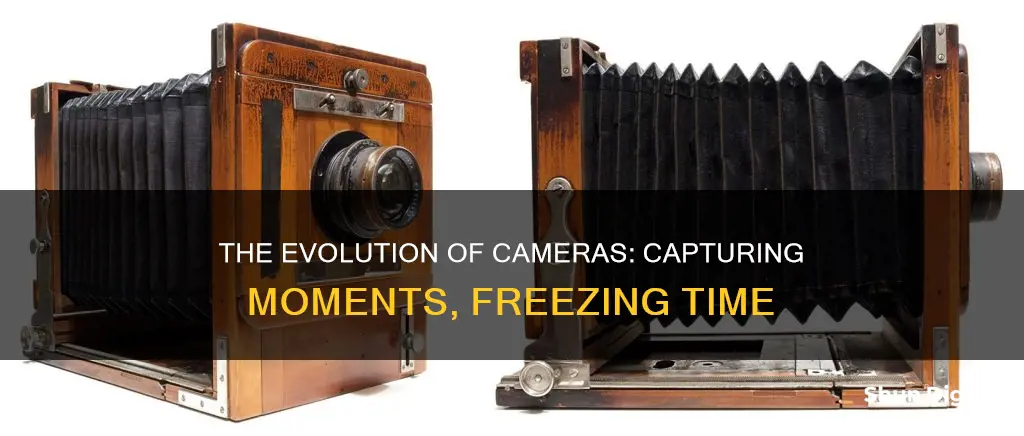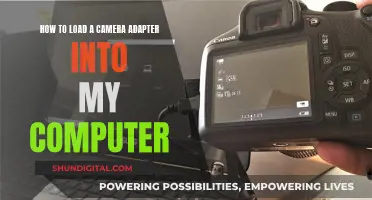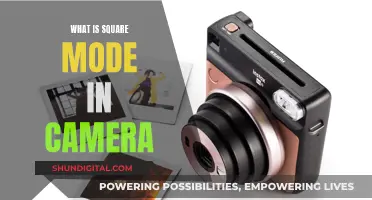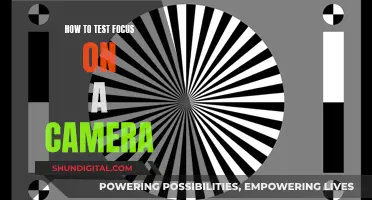
The history of the camera is a long and fascinating one, spanning centuries and involving numerous inventors and innovations. The first camera, or more accurately, the precursor to the modern camera, was the camera obscura, which in Latin means dark room. This device, which dates back to around 400 BC, was a darkened room or box with a small opening that projected an inverted image of the outside world onto a wall or screen. Over time, the camera obscura evolved, with lenses being used in openings from the 16th century onwards, and portable versions appearing by the 17th century. However, the images produced by these early cameras could not be preserved as no photographic processes had yet been invented.
The first permanent photograph was taken in 1826 or 1827 by Joseph Nicephore Niepce, who adapted the camera obscura to generate a photographic plate. Niepce experimented with various plates, ultimately settling on one coated with bitumen, which hardened in the brightest areas of the image. This process, which he called heliography or sun writing, produced the world's first photograph, an image of a courtyard at his residence in France.
In the early 1830s, Niepce formed a partnership with Louis-Jacques-Mande Daguerre, and the pair worked to refine the photographic process. Tragically, Niepce died in 1833, but Daguerre continued their work and in 1837, he created the first practical photographic process, which he named the daguerreotype. Daguerre treated a silver-plated sheet of copper with iodine vapour, sensitising it with light, and then developing it with mercury fumes to fix the image. This process produced extraordinarily detailed pictures, and Daguerre's camera and method became an immediate commercial success.
The daguerreotype defined cameras in the mid-19th century, but the quest for convenience and accessibility led to further innovations. George Eastman, who founded the Kodak company, was a key figure in this regard. In 1888, he created the first camera that used a single roll of celluloid emulsion film, called the Kodak. This camera captured negatives in fractions of a second and was marketed as a point-and-shoot option, with the film sent to Eastman Kodak for development. The Kodak camera was incredibly popular, and the company went on to introduce the Kodak Brownie in 1900, an inexpensive model that brought photography to most middle-class families.
The evolution of the camera continued with the introduction of 35mm film, instant cameras, digital cameras, and, eventually, smartphone cameras. Each of these milestones made photography more accessible, portable, and versatile, allowing people to capture and share important moments and events with ease.
What You'll Learn

To accurately capture the world
The history of the camera is a long and fascinating one, spanning centuries and involving numerous inventors and innovations. The desire to accurately capture the world has driven humanity to develop technology that has become an essential part of everyday life.
The first cameras, known as camera obscura, were not cameras in the modern sense but rather dark rooms with a small hole that projected an inverted image of the outside scene onto the adjacent wall. This principle, first described by Han Chinese philosopher Mozi around 470 to 391 BC, was used to view solar eclipses without harming the eyes and later as a drawing aid.
In the 16th century, lenses were introduced to the openings in camera obscura, improving image sharpness. By the late 17th century, portable versions of these devices, housed in tents and boxes, became commonly used for drawing. However, the images produced by these early cameras could only be preserved by manually tracing them, as no photographic processes had been invented yet.
The next significant development came in the early 19th century when French inventor Joseph Nicéphore Niépce experimented with silver chloride and silver halide photography. In 1826 or 1827, he adapted the camera obscura to generate a photographic plate, creating the first permanent photograph: a view from his workroom window in Saint-Loup-de-Varennes, France. This photograph, captured with an exposure time of around eight hours, is now exhibited at the University of Texas at Austin.
Following Niépce's pioneering work, French artist Louis Daguerre partnered with him to refine the photography process further. They invented the Daguerreotype camera, which used a shiny copper plate treated with chemicals to create images. Daguerreotypes were widely used in the mid-19th century due to their ability to produce detailed images quickly. However, the pictures tended to vanish quickly, and the camera did not sell well.
In 1841, William Henry Fox Talbot created the calotype process, the first to use a negative to create an image. This process involved using a chemically treated piece of paper to make a paper negative, from which multiple copies of a photo could be made.
The invention of roll film by George Eastman in the mid-1880s revolutionized photography once again. This lightweight and resilient film allowed for multiple quick-succession shots and became the standard for nearly a century. Eastman's first camera, called the Kodak, captured negatives in fractions of a second. The Kodak camera, along with its successor, the Brownie, made photography accessible to the masses, with the Brownie being the first time an affordable camera was available to most middle-class families.
The evolution of the camera continued with the introduction of 35mm film, instant cameras, and digital cameras, leading to the ubiquitous camera phones of today. Each milestone in the history of cameras has made it easier for people to capture important moments and events, transforming how we document and share our world.
Understanding Camera Raw: A Stand-Alone Powerhouse?
You may want to see also

To preserve images
The camera was invented to preserve images. Before the invention of the camera, there were two ways to capture the world around you: through verbal or written description, or by drawing or painting a scene. However, these methods were not reliable as words could be distorted, and drawings were dependent on the artist's skill and took a long time. Thus, there was a need for a way to accurately capture the world.
The first permanent photograph was invented by Joseph Nicéphore Niépce in 1826. He used a sliding wooden box camera made by Charles and Vincent Chevalier in Paris to capture the view from his window. The photograph was made using an 8-hour exposure on pewter coated with bitumen. Niépce called his process "heliography".
Niépce's photograph was a major milestone in the history of photography and the camera. However, the images produced by early cameras were blurry and unclear, and there was no way to fix the focus. Additionally, early cameras were large and required multiple people to operate them. It was not until the 1940s that colour photography became widely used and sold.
Over time, cameras evolved and improved in quality and portability. The Daguerreotype camera, invented by Louis Daguerre in 1839, was a significant improvement as it produced detailed images with shorter exposure times. This camera used a shiny copper plate treated with chemicals to create the image. Daguerre's camera and method became a commercial success and were widely used.
The Kodak No. 1 box camera, introduced in 1888, was a major step towards making photography accessible to the general public. This camera allowed anyone to take photos, and once the film was used up, it could be sent back to Kodak for development. The Kodak camera was followed by the Brownie camera in 1900, which was cheaper and less bulky, further expanding the market for amateur photographers.
The invention of the camera has come a long way, from large, room-sized cameras requiring multiple operators to modern compact digital cameras and smartphone cameras. Each advancement has made it easier for people to capture and preserve important moments and events, revolutionising the way we see and record the world around us.
Unlocking Camera Raw: The Power of Presets
You may want to see also

To improve upon the camera obscura
The camera obscura was a device that used a dark room or box with a small hole or lens to project an image from outside onto a surface inside. The image would be projected upside down, but the addition of a mirror could correct this. The camera obscura was used as an aid for drawing and entertainment.
The camera obscura was a very old device, with the oldest mention of its effect by the Chinese philosopher Mozi in the 5th century BC. Mozi noticed that the image from a camera obscura was flipped upside down because light travels in a straight line. Other scientists and philosophers such as Aristotle, Anthemius of Tralles, and Al-Kindi also experimented with the camera obscura and the behaviour of light. However, it was not until the 11th century that the scientist, mathematician, astronomer, and philosopher Alhazen (also known as Ibn al-Haytham) suggested using a screen to project the image from one side of the hole to the other.
In the 15th century, artists began to use the camera obscura as a drawing aid. However, using the device sparked controversy, as many viewed the tracing method as cheating. The first clear description of the camera obscura was published by Leonardo da Vinci in his Codex Atlanticus in 1502. Over the years, da Vinci drew around 270 diagrams of the camera obscura in his sketchbooks. He also compared the human eye to the camera obscura, writing:
> The image is let into the eye through the eyeball just as here through the window.
In the 16th century, the camera obscura was further developed by Italian scholar Giambattista della Porta, who added a concave lens near the pinhole where light enters the box. This improvement allowed users to adjust the focus. Della Porta also used the camera obscura to explain how the human eye works. He wrote:
> For the image is let into the eye through the eyeball just as here through the window.
The camera obscura was the basis for early photographic cameras. The introduction of a light-sensitive plate created photography.
Smart Strategies for Carrying Extra Camera Batteries
You may want to see also

To develop a commercial product
The first cameras were very different from the devices we know today. The first camera, or "camera obscura", was invented around 400 BC. It was a dark room with a small hole that projected an inverted image of the outside onto the wall. This technology was used to view solar eclipses without damaging one's eyes and later as a drawing aid.
The camera's evolution from a dark room to a portable device took centuries and involved many inventors. In the 16th century, rudimentary lenses improved image quality, and by the 17th century, portable versions of the camera obscura were available.
The first photographic camera was developed in 1816 by Joseph Nicephore Niepce, a French inventor. However, the camera's origin relied on centuries of contributions. Niepce created photographic images on silver chloride-lined paper, and the oldest surviving photograph is one he made around 1826. The original shot is still on exhibit at the University of Texas at Austin.
In the 1830s, Niepce's partner, Louis Daguerre, continued to experiment and created the first practical photographic process, which he named the daguerreotype. This process involved treating a silver-plated sheet of copper with iodine vapour to give it a light-sensitive coating of silver iodide. After exposure in the camera, the image was developed using mercury vapour and fixed with a strong solution of ordinary salt (sodium chloride).
The first photographic camera developed for commercial manufacture was a daguerreotype camera, built by Alphonse Giroux in 1839. Giroux signed a contract with Daguerre and Isidore Niepce (Niepce's son) to produce the cameras in France, with each device and its accessories costing 400 francs.
The daguerreotype camera was soon followed by other types of cameras, such as the calotype camera invented by William Henry Fox Talbot in 1841. Talbot's process used a chemically treated piece of paper to make a paper negative, which could then be used to make multiple copies of a photo.
In the late 19th century, George Eastman pioneered the use of photographic film with his Kodak camera, first offered for sale in 1888. This camera was a simple box camera with a fixed-focus lens and a single shutter speed. It came pre-loaded with enough film for 100 exposures and needed to be sent back to the factory for processing and reloading when the roll was finished.
The Kodak camera was followed by other models, such as the Brownie in 1900, which was far less bulky and much cheaper than previous cameras, selling for just $1. It became the most popular camera of the 20th century due to its ease of use and affordability.
In summary, the development of a commercial camera product was a long and complex process that involved many inventors and innovations. The first cameras were large and unwieldy, and the process of capturing and developing images was time-consuming and complex. Over time, cameras became more portable, easier to use, and more affordable, eventually becoming a household object and an essential part of everyday life.
Undoing Actions: Camera Raw's Secret Superpower
You may want to see also

To make photography accessible
The history of the camera is a long and fascinating one, with the first permanent photograph being invented over a century before portable cameras were available to the public. The development of photography and cameras has been driven by the desire to accurately capture the world around us and make this technology accessible to all.
The first permanent photograph was taken in 1826 by French scientist Joseph Nicéphore Niépce, using a camera obscura and a pewter plate coated with bitumen. This process, which Niépce called "heliography", took eight hours to create an image of the view from his window. This was a significant milestone, as it addressed the limitations of relying on verbal or written descriptions, drawings, or paintings to capture a scene, all of which were susceptible to distortion, required artistic skill, and could result in important details being missed or lost.
The invention of photography as we know it today was made possible by Niépce's experiments with silver chloride and silver halide photography. This led to the creation of the Daguerreotype camera by French artist Louis Daguerre, who partnered with Niépce to refine the process. They developed the idea of capturing images on a shiny copper plate treated with chemicals. This collaboration laid the foundation for modern photography.
The evolution of camera technology progressed with the introduction of flexible roll film by George Eastman in the mid-1880s. This innovation made photography accessible to amateurs and revolutionised the field. Eastman's first camera, the "Kodak", offered 100 exposures and needed to be sent back to the factory for processing and reloading. This camera appealed to the average consumer with its relatively low price and ease of use.
The democratisation of photography continued with the introduction of the Brownie camera by Kodak in 1900. Selling for just $1, this camera was far less bulky and more affordable than its predecessors. The Brownie camera played a pivotal role in expanding the market for amateur photographers and became the most popular camera of the 20th century.
In the following decades, camera technology continued to advance, with the Leica camera introduced in 1925, becoming the first compact camera with a good lens capable of shooting photos on 35 mm film. This camera set a new standard for modern cameras and contributed to the growing accessibility of photography.
Today, the development of digital cameras and camera phones has further democratised photography, allowing anyone with a smartphone to capture and share images instantly. The integration of artificial intelligence (AI) in camera technology has also played a significant role in making creative photography more accessible to the masses.
Cleaning Your Adorcam Camera Charging Port: A Step-by-Step Guide
You may want to see also







